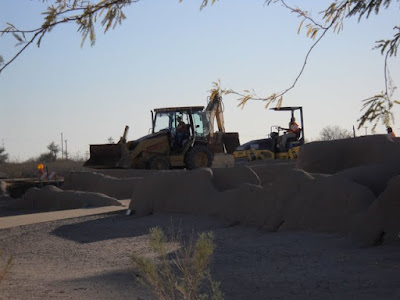

They began the work days--or weeks--before we arrived on Monday. Today the theory is that keeping artifacts in their original place and covering them back up with dirt is the best way to take care of them and the site. Here they aren't actually burying the ancient community, but they are filling in between the buildings with sterile soil. This helps stabilize the building walls, as well as correcting the slope of the surface where visitors walk to enable the periodic rains to run off without doing damage to the site. Apparently the first step in the work was a detailed survey to determine how much dirt to fill in at each point in the complex. We aren't sure what everything will look like until the work is complete.
One of the archaeologists on the crew is also a flintknapper. That is the ancient process of making stone tools. I had never watched anyone flintknap before. Alan was so excited about both the various stones he has to be made into tools and the process itself. It was hard not to get excited, just listening to him.
First he showed us several different pieces of stone, from Montana, Colorado, Wyoming, Australia and other places. Some of the stone he collected himself, such as while working on a pipeline project in Wyoming. Others he bought at the annual Tucson Gem and Mineral Show.
Here he is holding a hammer stone in his right hand and a fairly large piece of stone from Knife River in his left.

He worked on this stone for over 30 minutes. At his feet you can see some other stones he could work with, as well as some of his tools, which are either pieces of stone or of the antlers of deer and elk.

He chipped away at the stone, removing both large and small pieces of rock. He uses his knee as a work surface.


Finally, from a piece of stone slightly smaller than his fist, this is the spear point he made. Isn't that incredible?


That is truly remarkable that he could fashion a point in a traditional manner. It is a combination of the right materials for hammer and point as well as skill. I understand such points can be as sharp as a modern knife. We need to recognize that native technology was quite good and very appropriate for where people lived.
ReplyDeleteHere in the North the birch bark canoe and the snowshoe are as perfect and appropriate as you could imagine, fashioned just with simple hand tools. Less well known and appreciated is the curved knife which allowed the craftsman to draw it towards him while steadying the wood with his other hand, (no vice required.)